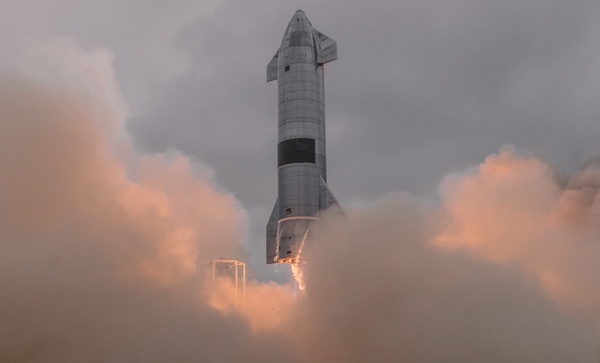Build back betterby Robert G. Oler
|
| SpaceX is creating a space effort fundamentally different than anything that has gone before and is essential for a future different from the past. |
Most NASA contractors spend government money with no hint of their own investment. They believe that there is no customer base outside of NASA. The goal is another multi-decade run like the shuttle and station, all on the government’s nickel. The main goal of SLS and Orion is preserving government created jobs. Artemis is, in everything including name, a bigger Apollo.
Falcon 9 and Falcon Heavy boosters, the products of substantial private investment, have been the most successful development in space lift since Atlas. Their innovative engineering of traditional concepts is, with each launch, changing the lift equation through cost, reusability, and expanded markets. Crew Dragon has continued this trend.
Combined, Falcon and Dragon are what the space shuttle system promised and failed to deliver. The Falcon first stage and Dragon capsule are reusable at a cost level and tempo that would have made the Space Transportation System a success. That success has brought in “nonstandard” customers.
SpaceX and its supply/vendor chain are a free enterprise success story. These are not private industry jobs in name only, rather a system of capital, risk, and solid engineering creating a commercial product. Success trickles up. Musk is going to fly two completely private vehicles responding to not a NASA program, but instead the demands of free enterprise. This creates a space effort fundamentally different than anything that has gone before and is essential for a future different from the past.
Starship is innovation that redefines traditional design. Success of the lunar lander version implies success of the entire Starship system, most importantly the infrastructure that goes with it.
| Success of the lunar lander version implies success of the entire Starship system, most importantly the infrastructure that goes with it. |
The vision of the past is the space frontier summoned through a government funnel. Current policy is content with yearly missions of four astronauts going to the Moon on an SLS/Orion launch costing $2–3 billion so that two of them can get into a lunar Starship for a week. If Starship works, it is not hard to imagine SpaceX sending four more people on the Starship system, or even an entire lunar mission of eight or more from various groups and industry in the US: missions flown frequently and routinely and, in comparison, cheaply.
This will allow the entire nation to dream and scheme as to the visions of what can be done in space by both humans and machines. Private business, the military, and individuals can explore how to import the space frontier into their American dream. That will change is how America defends itself, creates products, and conducts recreation. It could change our entire economy.
Already, the public image of space exploration is shifting from the glacial pace of SLS and Orion to the tempo of events generated by SpaceX. This shift will redefine the risk in human spaceflight.
Traditionally, the risk to the men and women in human spaceflight is defined solely by success or failure in accomplishment. This is unique in American endeavors, where hoped-for rewards are a justification for risk; a balance that is measured by, and solely shared among, the people involved and financing the endeavor. In the past 60 years that balance has been elusive for human flight into space.
The entrance of private capital and customers is evolving human spaceflight to become as other sectors of American life. From the effort in general to the technology and products involved. The rewards from the effort and risk will define success and failure
| Orion, SLS, and past policy, projected into the future, all promise few changes for those future taxpayers over what their parents and grandparents financed. |
“We’re in competition with China and other countries to win the 21st century. We’re at a great inflection point in history. We have to do more than just build back, we have to build back better.” President Biden said in his recent address to the nation and Congress.
In 2061, a mere 40 years away, humanity will celebrate 100 years of human spaceflight. This is within the natural lifetime of all born in this century.
Orion, SLS, and past policy, projected into the future, all promise few changes for those future taxpayers over what their parents and grandparents financed. There will be gender and racial diversity in national space efforts, but it is the predictable path.
Build back better? It is July 14, 1954, and the Boeing Dash 80 (the forerunner of the 707) is soaring overhead. You are asked to predict jet transportation in 1994. The only correct answer is, “Yhe change will be unrecognizable.” If Starship works, this is the next 40 years in human spaceflight.
Note: we are using a new commenting system, which may require you to create a new account.
